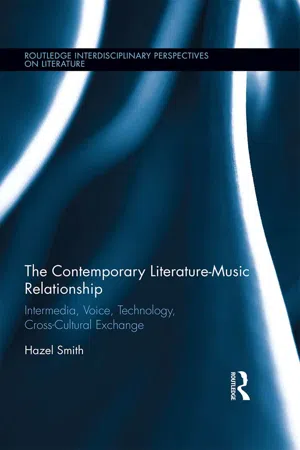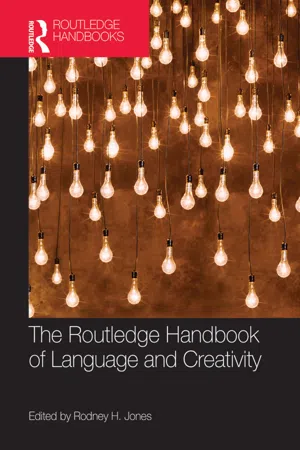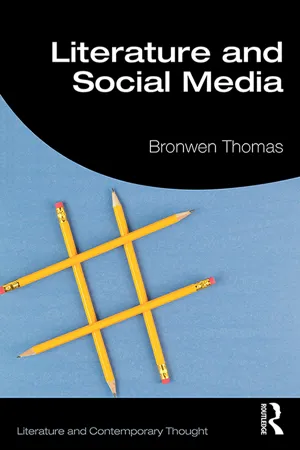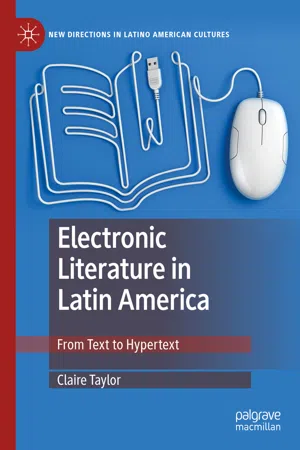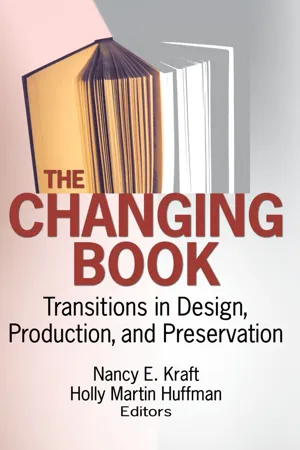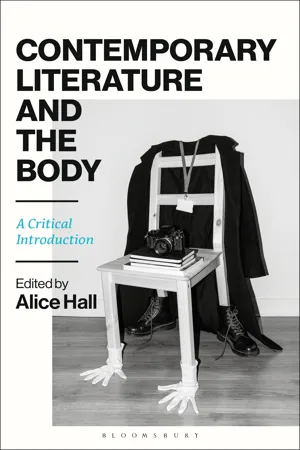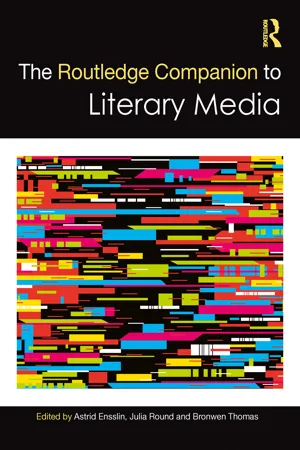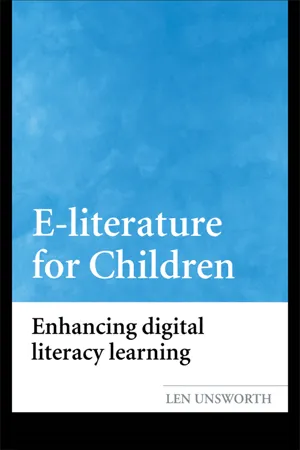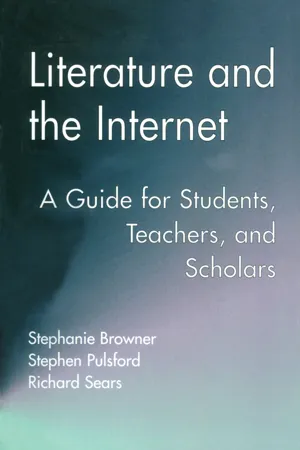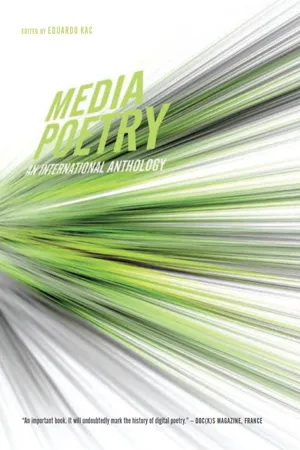Literature
Electronic Literature
Electronic literature refers to literary works created and experienced on digital platforms, often incorporating multimedia elements such as hypertext, animation, and sound. It encompasses a wide range of genres and forms, including interactive fiction, poetry, and kinetic typography. Electronic literature challenges traditional notions of textuality and offers new modes of storytelling and reader engagement.
Written by Perlego with AI-assistance
Related key terms
Related key terms
1 of 4
Related key terms
1 of 3
11 Key excerpts on "Electronic Literature"
- eBook - ePub
The Contemporary Literature-Music Relationship
Intermedia, Voice, Technology, Cross-Cultural Exchange
- Hazel Smith(Author)
- 2016(Publication Date)
- Routledge(Publisher)
There are many different types of Electronic Literature, and it is known variously by terms that are either synonyms for it or address various aspects of it. These terms include new media writing, digital literature, networked and programmable writing and algorithmic or computational writing, as well as the shortened form e-lit. Electronic Literature is also referred to more generically as electronic poetry, interactive fiction or algorithmic text generation and historically as hypertext, story space fiction or flash poetry (some of which name redundant or near-redundant software). In fact, the terminology is evolving all the time as new technologies emerge. At a more general level, Electronic Literature may be subsumed into, and is continuous with, broader categories of new media art. For a more detailed account of Electronic Literature, and its histories, see Hayles (2008), Glazier (2002) and Morris and Swiss (2006). - eBook - ePub
Towards a Digital Poetics
Electronic Literature & Literary Games
- James O'Sullivan(Author)
- 2019(Publication Date)
- Palgrave Macmillan(Publisher)
Electronic Literature’s structural relationship with computation, which evolves at an exponential rate, is such that the form will never be static; thus, our only alternative is to cast a wide taxonomic net, and resolve peculiarities as they arise. Electronic Literature is that which combines the electronic, the screen—digital or otherwise—with the literary, presenting, often through a multiplicity of modes, an assemblage that might privilege either, but will always feature, these two essential elements. That is all it is, and to say so might not really tell us anything. But like literature, we know it when we see it. The Emergence of Electronic Literature The theme for the Electronic Literature Organization’s 2015 gathering in Bergen was “the ends of Electronic Literature”. Anastasia Salter explains that this theme emerged from the realisation that the digital is no longer other, and so we should abandon terms that reassert old distinctions: Is the choice to use words like “electronic” or “digital” to designate our work and pedagogy simply a reflection of a moment of transition, soon to be abandoned as such methods become universal, or is it still important to call attention to the use of technology as we push it towards new frontiers? (Salter 2015) It is true to say that Electronic Literature is literature, but to suggest that we have moved to a point where distinction is no longer valid seems premature. There are dead technologies and there are technologies yet to be born—there are practices considered Electronic Literature by some, and not by others - Rodney H. Jones, Rodney H. Jones(Authors)
- 2015(Publication Date)
- Routledge(Publisher)
The most popular misconception is to understand text appearing in digital media as digital text or, to use the concept more important for the discussion at hand, digital literature. This is not very different from saying that a story read on the radio is a radio play. To avoid such misconceptions, it has been asserted that digital literature should be ‘born digital’. However, this stricture does not help much if it is understood as a requirement to create the text on or using a computer: typing a novel using a keyboard and reading it on the screen does not turn it into digital literature. The Electronic Literature Organization (ELO), founded in 1999 ‘to foster and promote the reading, writing, teaching, and understanding of literature as it develops and persists in a changing digital environment’, tries to be more precise when answering the question of what is Electronic Literature: ‘Electronic Literature, or e-lit, refers to works with important literary aspects that take advantage of the capabilities and contexts provided by the stand-alone or networked computer’ (ELO, 1999). This definition introduces a second problem – without really solving the first – by shifting from ‘ digital environment’ to ‘ Electronic Literature’. Leaving alone the troubled waters of ‘important literary aspects’, a poem using the distribution facility of email or weblogs – thus taking advantage of the capabilities of a networked computer – is still a poem. No matter how we eventually define the specific ‘literariness’ of digital literature, it is evident that it undermines the identity of digital literature as literature. In addition to the sine qua non of literariness, there is another sine qua non regarding the essence of digital literature: that it is more than literature in the traditional sense. By definition, digital literature has to go beyond the employment of letters and it has to make aesthetic use of the features of digital media- eBook - ePub
- Bronwen Thomas(Author)
- 2020(Publication Date)
- Routledge(Publisher)
Both the theory and practice of Electronic Literature also demonstrate a close connection with performance and gaming. For example, Ensslin’s (2014) work situates itself on a ‘literary- ludic spectrum’, arguing both for the literariness of some videogames and for the game-like qualities of digital fictions. Although Electronic Literature is now about much more than words and text, a strong focus on language and formal experimentation persists. Creators of hypertext fiction and early forms of Electronic Literature not only perceived themselves to be in the vanguard of experimentation with literary form, but also had to be technically proficient, understanding code and software as well as the commercial imperatives affecting the distribution and uptake of their works. Novelistic representations of computers and communication technologies from the same period primarily portrayed them as mechanistic or alienating, a threat to culture and civilisation, or as the trigger for comic scenes based on the ineptitude of users (Thomas 2012). By the end of the twentieth century, however, there is undoubtedly a growing sense of inevitability about the role of technology in the production and consumption of literary texts, with computers becoming less of a curiosity and more of a necessity for writers. Interviewed in 2000, Martin Amis admitted to relying more and more on his computer, despite describing this shift as ‘sinister’, and bemoaning the loss of the ‘slightly painterly feel’ of writing in longhand (Richards 2000) - eBook - ePub
Electronic Literature in Latin America
From Text to Hypertext
- Claire Taylor(Author)
- 2019(Publication Date)
- Palgrave Macmillan(Publisher)
© The Author(s) 2019 C. Taylor Electronic Literature in Latin America New Directions in Latino American Cultures https://doi.org/10.1007/978-3-030-30988-6_1Begin Abstract1. From Text to Hypertext: Electronic Literature in Latin America
End AbstractClaire Taylor1(1) Department of Modern Languages and Cultures, University of Liverpool, Liverpool, UKThis book proposes a framework for understanding contemporary digital literary genres and the complex negotiations they undertake with earlier literary experimentation . Arguing that digital literature must be understood not as a radical break with prior norms, but as works on a continuum, this book charts the ways in which selected authors of digital works in the Hispanic world speak back to the rich tradition of literary experimentation , which goes well beyond the Anglophone. For the purposes of this book, six landmark authors and their works at different stages of the development of Electronic Literature as a phenomenon in the Hispanic world have been selected. In my analysis, I distinguish two main features that can be identified as commonalities in their works: firstly, the combination of intertextual and metatextual plays; and secondly, the critique of digital technologies and their (perceived or actual) imbrication in the technocapitalist system underpinning them.Regarding the first of these—intertextual and metatextual plays—I argue for a position that is not an unproblematically laudatory one that sees digital literary production as a radical break with the printed form that is, in and of itself, empowering, liberatory, or even revolutionary. Instead, I argue, we must conceive of digital literature as being in negotiation with previous literary forms so that it functions as both continuum and break. At the same time, I situate this development in a context that goes well beyond the more conventionally noted Anglophone one, and I undertake a detailed analysis of pre-digital literary experimentation across a range of national and transnational contexts, demonstrating how the characteristics of these prior experimentations continue to manifest themselves—and yet, are also inflected differently—in contemporary digital literature. I advocate establishing and tracing connections, both implicit and explicit, underscoring the national, regional, and transnational dialogues that these digital literary genres undertake with previous literary canons, texts , techniques, and genres . My focus on these works as the inheritors of long-established literary traditions thus builds an argument about how radical literary traditions, both past and present, continue to make incisive contributions to ongoing debates about digital technologies —debates which also have ideological and political implications. In so doing, I focus on the dialogues between literariness and technology , and I reveal the tensions that are established between moments of utopian radicalism and moments of highlighting the limitations of digital technologies - eBook - ePub
The Changing Book
Transitions in Design, Production, and Preservation
- Nancy Kraft, Holly Huffman(Authors)
- 2018(Publication Date)
- Routledge(Publisher)
The Future of Literature: Complex Surfaces of Electronic Texts and Print Books N. Katherine HaylesSUMMARY. A group of contemporary print novels has emerged that entwine narrative with the expanded resources of the print book considered as a visual as well as a verbal medium. These novels appropriate and rerepresent in their own expanded forms many other media types. The dynamic suggests that the novel itself as a form is undergoing the traumatic experience of having its traditional territory taken over by the colonizing incursions of other media. These books respond to this trauma by bursts of anxious creativity, thereby changing what it means to be a novel in print. doi:10.1300/J105v31n01_06 [Article copies available for a fee from The Haworth Document Delivery Service: 1-800-HAWORTH. E-mail address: <docdelivery@ haworthpress.com > Website: < http://www.HaworthPress. com > © 2006 by The Haworth Press, Inc. All rights reserved.]Keywords.
Electronic text, literature, print books, digital mediaIntroduction
Nothing is riskier than prediction; when the future arrives, we can be sure only that it will be different than we thought. Nevertheless, I will risk a prognostication: digital literature will be a significant component of the 21st century canon. Less a gamble than it may appear, this prediction slyly relies on the fact that almost all contemporary literature is already digital. Except for a handful of books produced by fine letter presses, print literature consists of digital files through most of its existence. So essential is digitality to contemporary processes of composition, storage and production that print should properly be considered a particular form of text for digital files rather than a medium separate from digital instantiation. The digital leaves its mark on print in new capabilities for innovative typography, new aesthetics for book design, and in the near future, new modes of marketing. Some bookstores and copy shops, for example, are investing in computerized xerography machines that produce books on the spot from digital files, including cover design, content, and binding.1 - eBook - ePub
Contemporary Literature and the Body
A Critical Introduction
- Alice Hall(Author)
- 2023(Publication Date)
- Bloomsbury Academic(Publisher)
4 Electronic Literature Elizabeth LoshFor many decades, Electronic Literature was best known for producing works in emerging genres that were designed primarily for desktop computers. Text and images usually appeared on a monitor positioned in front of the user. Although the experience of reading might require input from a keyboard or mouse that disrupted conventions about how the text was delivered for consumption by the eye, the substitution of screen for page did not radically reconfigure the relationship between the reader’s body and textual discourse, as the user progressed through her or his literary encounter with either a two-D hypertext page or a one-D output line of code.This did not mean that the body was not a matter of concern for pioneering digital authors. It might even be a central topic in a work, as is the case in Shelley Jackson’s My Body – a Wunderkammer (1997), in which the main navigation presents the reader with a choice of rectangles focused on different parts of a woman’s body. In exploring the different anatomical segments represented by woodcut illustrations, the reader learns intimate details about the narrator’s embodied experiences, such as what it feels like to have a nostril pierced or to be surprised by tender nipples during puberty.With a similar interest in fragmented subjectivity, Juliet Davis’s Pieces of Herself (2005) uses the trope of dressed-up paper dolls to structure a journey that interrogates the central figure’s sex, gender and female identity by constructing a massive collage selected from hundreds of digital photographs and audio clips. Using a drag-and-drop game interface, viewers scroll through conventional environments for gender play to collect ‘pieces’ of the self and arrange them inside an outline of a female body. As each piece enters the representation of feminine corporeality, it triggers audio derived from interviews with women, music loops or sound effects. Inspired by ‘Elizabeth Grosz’s theories about embodiment’, the author describes Pieces of Herself as a comment upon the ‘social inscription of the body’.1 - eBook - ePub
- Astrid Ensslin, Julia Round, Bronwen Thomas, Astrid Ensslin, Julia Round, Bronwen Thomas(Authors)
- 2023(Publication Date)
- Routledge(Publisher)
What is Literary Media? Astrid Ensslin, Julia Round and Bronwen ThomasDOI: 10.4324/9781003119739-1It has been over a decade since, in her groundbreaking book Electronic Literature: New Horizons for the Literary (2008 ), N. Katherine Hayles challenged the rigid, exclusive and somewhat obsolete institutional and ideological connotations of the term ‘literature’ in a fast-transforming media landscape. She called for a ‘broader category that encompasses the kind of creative … artworks that interrogate the histories, contexts and productions of literature, including as well the verbal art of literature proper’ (45). This proposed category, called ‘the literary’, reflects the seismic impact of contemporary digitalisation and the increasing cross-pollination of literary studies with such diverse disciplines and movements as media and cultural studies, social, environmental and computational sciences, pop, fan and participatory cultures.This volume situates its exploration of ‘literary media’ against this backdrop, asking what happens when we expand the horizons of what can be considered literary still further. Whereas Hayles’ concept still posits the literary as a distinct category, and confines itself to works that define themselves as creative/artistic, our definition of ‘literary media’ includes popular cultural forms and media and cultural texts that do not necessarily overtly align themselves to the literary. This may also include paratextual materials, and an approach and method that includes discussion of specific aspects of the socio-political, industry and commercial contexts, as well as analysis of specific texts or works. Fundamentally, instead of keeping the literary and the media as separate categories, we focus on an interdependence of the literary and its diverse forms of mediation that is increasingly apparent in this era of global late capitalism. The term ‘literary media’ for us therefore far exceeds notions and connotations of ‘art’ and unsettles the continuing privileging of ‘literature proper’. Our formulation derives from and has particular resonance for scholars working at the intersection of literary and media studies and reflects wider shifts in both institutional structures and the long established boundaries or silos of traditional academic disciplines. - eBook - ePub
E-literature for Children
Enhancing Digital Literacy Learning
- Len Unsworth(Author)
- 2005(Publication Date)
- Routledge(Publisher)
Chapter 5 Emerging digital narratives and hyperfiction for children and adolescents Introduction New electronic forms of literary narratives for children and adolescents are emerging on the web and, to a lesser extent, on CD-ROMs. This chapter discusses examples of these new digitally originated literary texts, proposing a simple framework for describing the range of narrative forms and their compositional features, and indicating ways in which classroom work with children can address these new forms of narrative experience. In this introductory section, five distinct types of digital narrative are identified as well as two types of digital poetry and two categories of digital comics. (The integrative electronic game/narrative is dealt with separately in the next chapter.) Five aspects of the compositional features of these texts are also identified and a tentative sketch of a framework relating the types of texts and their compositional features is provided. In the subsequent sections of the chapter, examples of each of the types of digital literature are discussed and practical teaching/learning activities are indicated. The forms of digital narrative for children and adolescents seem to fall into the following categories: e-stories for early readers —these are texts which utilize audio combined with hyperlinks to support young children in learning to decode the printed text by providing models of oral reading of stories and frequently of the pronunciation of individual words; linear e-narratives —these are essentially the same kinds of story presentations which are found in books, frequently illustrated, but presented on a computer screen; e-narratives and interactive story contexts —the presentation of these stories is very similar to that of linear e-narratives, however the story context is often elaborated by access to separate information about characters, story setting in the form of maps, and links to factual information and/or other stories - eBook - ePub
Literature and the Internet
A Guide for Students, Teachers, and Scholars
- Stephanie Browner, Stephen Pulsford, Richard Sears(Authors)
- 2013(Publication Date)
- Routledge(Publisher)
Chapter 8 Literary Texts and Literary Careers in the Electronic Age IntroductionIn this chapter, we focus on the technical, editorial, and professional issues raised by the use of computers to produce, distribute, preserve and study electronic texts. Part 1 explains how texts are encoded. Part 2 surveys issues and debates in scholarly electronic editing and lists the new MLA guidelines for electronic editions. Part 3 briefly discusses the issues libraries confront in developing online resources. Finally, Part 4 surveys the impact of computers on academic careers.1. Electronic Texts and Archives DreamsAlthough this section surveys the technology underlying literature pages on the Internet, it is exciting to begin with imagining all that we might want from the digital revolution. Dreaming suggests what may be possible in the near future and also encourages us to evaluate current electronic resources by what we desire rather than by what is feasible. Fantasies about what to do with computers and literature also allow us to push computer scientists, electronic editors, and others to build the hardware, software, and electronic texts, archives, and libraries that we want.So, what might we want from a full electronic archive? First, all versions of a text should appear in a fully searchable electronic form, along with all the texts and documents (letters, journal entries, publishing records) relevant to the history of the text. We will want digital images of manuscripts and important editions or other documents and a wealth of contextual material, including explanatory notes, annotations, maps, historical documents, reviews, critical commentaries, bibliographies, and maybe even film adaptations or recordings.The creator of an archive makes difficult decisions about its boundaries—what is and what is not relevant—and must bring intellectual integrity and vision to the collection. Once collected, however, we want this material richly linked so that hot buttons, pop-up windows, and menus allow easy access to annotations, variant texts, parallel texts, and critical commentary. The archive should be user-friendly to undergraduate students and useful to advanced scholars. We want navigational tools that allow us to wander widely and yet know where we are in relation to our own wanderings and also in relation to the structure of the entire archive. We want software that allows us to do smart searches of images and texts, to construct concordances and indexes, and to perform stylistic analyses, and we want an interactive, flexible archive that allows us to reconstruct texts, reconfigure materials, and add our own marginal notes. - eBook - ePub
Media Poetry
An International Anthology
- Eduardo Kac, Eduardo Kac(Authors)
- 2007(Publication Date)
- Intellect Books(Publisher)
This growth is taking place in cyberspace, in what many critics might well have considered an environment hostile to cultivated ‘letters’, hostile, at the very least, to the traditional and still pre-eminent delivery media which have made language visible. The narrow bandwidth of current networks, and the limited capabilities of affordable interfaces meant that encoded text was, originally, the dominant medium of information exchange on computer-based networks. And to communicate over these networks, people still, predominantly, write and read. That is, they compose (literary) texts and publish them in cyberspace where they are read, usually in silence, by friends, colleagues, and the more general, ‘wired’ public. All this has stimulated the emergence of an exuberant mass of new forms and proto-genres of visible language: listserve mailing lists, online conferences or ‘chat’ zones, MOO spaces and so on. The advent of the World Wide Web has extended and articulated networked literary production to include typographic and other concrete design aspects of textuality. However, the vast majority of this visible language is not seen by its writers or readers as belonging to ‘literary’ or ‘artistic’ production in the canonical sense. ‘Serious’ literary hypertext does exist and is practised increasingly in this context. 4 However, it is perhaps more significant, in cultural terms, that the new quasi-ephemeral forms of non-literary visual language are exerting an increasing influence on self-consciously literary production, in what might be characterized as the real-time realization of contemporary criticism’s postmodern intertextual ideals. 5 But this temporary state of affairs, this a momentary window of opportunity for the partisans of visible language, cannot last
Index pages curate the most relevant extracts from our library of academic textbooks. They’ve been created using an in-house natural language model (NLM), each adding context and meaning to key research topics.
Explore more topic indexes
Explore more topic indexes
1 of 6
Explore more topic indexes
1 of 4
